Zesty, vibrant, and wonderfully versatile—Filipino pancit dishes are about to become your new favorite weeknight heroes. Whether you’re craving quick noodles, comforting classics, or something fresh for a crowd, this roundup brings the authentic flavors of the Philippines straight to your kitchen. Dive into these 21 exciting recipes and discover just how easy it is to whip up a delicious pancit creation tonight!
Classic Pancit Canton with Chicken and Vegetables
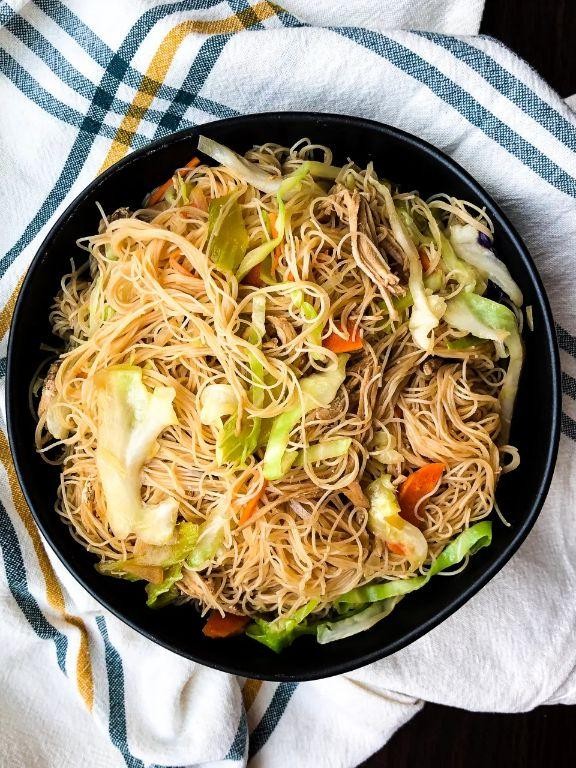
Nothing quite captures the comforting essence of Filipino home cooking like a steaming platter of Pancit Canton. This beloved stir-fried noodle dish, with its vibrant medley of textures and savory-sweet sauce, transforms simple ingredients into a celebration on a plate. Let us guide you through creating this classic version with tender chicken and crisp vegetables.
Ingredients
- 8 ounces Pancit Canton noodles (I always keep an extra pack in the pantry for last-minute cravings)
- 1 pound boneless, skinless chicken thighs, cut into 1-inch pieces (thighs stay wonderfully juicy, but breast works too)
- 2 tablespoons vegetable oil (a neutral oil lets the other flavors shine)
- 4 cloves garlic, minced (freshly minced makes all the difference)
- 1 medium yellow onion, thinly sliced
- 2 medium carrots, julienned
- 1 cup green beans, trimmed and cut into 2-inch pieces
- 1/2 small cabbage, thinly sliced
- 1/4 cup soy sauce
- 2 tablespoons oyster sauce
- 1 teaspoon freshly ground black pepper
- 4 cups chicken broth (homemade broth elevates it, but a good quality store-bought works beautifully)
- 2 stalks green onions, sliced for garnish
- 1 lemon, cut into wedges for serving (a generous squeeze at the end is non-negotiable)
Instructions
- Place the Pancit Canton noodles in a large bowl and cover with warm water; let them soak for 10 minutes until pliable but not fully soft, then drain completely. This prevents them from becoming mushy during stir-frying.
- Heat the vegetable oil in a large wok or deep skillet over medium-high heat until it shimmers, about 1 minute.
- Add the chicken pieces and cook, stirring occasionally, for 5-7 minutes until they are golden brown and cooked through.
- Push the chicken to one side of the wok and add the minced garlic and sliced onion to the empty space; sauté for 1 minute until fragrant.
- Add the julienned carrots and green beans to the wok and stir-fry with the chicken, garlic, and onion for 3 minutes until the vegetables begin to soften.
- Pour in the soy sauce, oyster sauce, and black pepper, stirring quickly to coat all ingredients evenly.
- Add the thinly sliced cabbage and toss for 1 minute until it just begins to wilt.
- Pour in the chicken broth and bring the mixture to a vigorous boil, which should take about 2 minutes.
- Add the drained noodles to the wok, gently tossing and folding them into the broth and vegetable mixture until most of the liquid is absorbed, about 4-5 minutes. For the best texture, avoid overcooking—the noodles should be tender but still have a slight bite.
- Garnish with sliced green onions and serve immediately with lemon wedges on the side.
Remarkably satisfying, each forkful offers a harmony of soft noodles, savory chicken, and the crisp freshness of vegetables. The final squeeze of lemon brightens the entire dish, cutting through the richness with a zesty spark. For a festive touch, serve it family-style in a large, shallow platter, allowing everyone to gather around and savor this taste of Filipino comfort.
Pancit Bihon Guisado with Shrimp
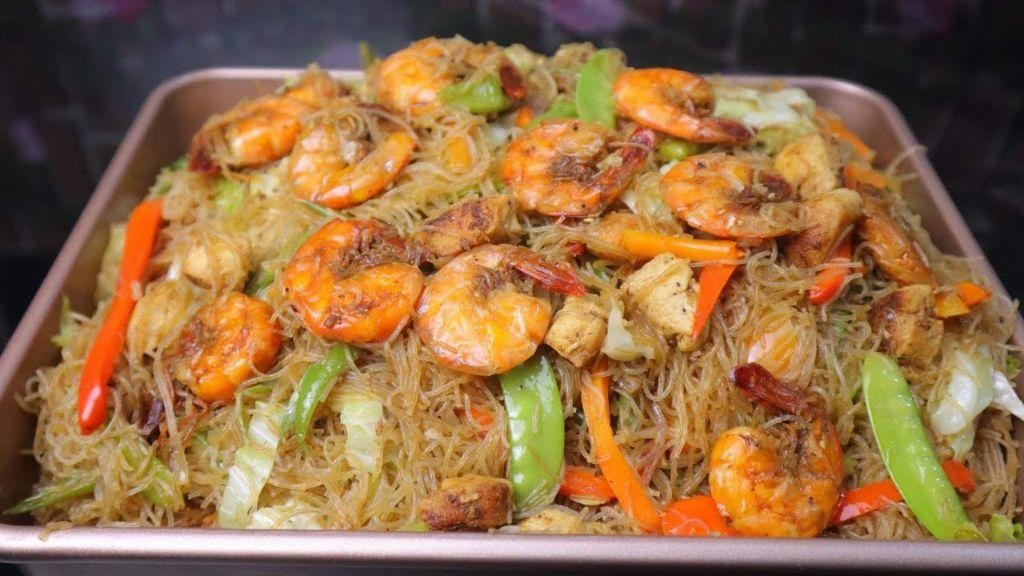
Elevating the humble noodle to new heights, Pancit Bihon Guisado with Shrimp transforms simple ingredients into a vibrant, satisfying meal that sings with Filipino flair. This classic dish balances delicate rice noodles with plump shrimp and crisp vegetables in a savory-sweet symphony that’s as comforting as it is elegant.
Ingredients
- 8 ounces rice sticks (bihon)—I always soak these briefly to prevent breakage
- 1 pound medium shrimp, peeled and deveined—save those shells for a quick stock if you’re feeling ambitious
- 2 tablespoons vegetable oil—a neutral oil lets the other flavors shine
- 4 cloves garlic, minced—freshly crushed releases the most aromatic oils
- 1 medium onion, thinly sliced—yellow onions add a subtle sweetness
- 2 carrots, julienned—their bright color makes the dish pop
- 2 cups green cabbage, shredded—I prefer savoy cabbage for its tender leaves
- 1/4 cup soy sauce—use low-sodium to control saltiness
- 2 tablespoons oyster sauce—this adds that essential umami depth
- 4 cups chicken broth—homemade elevates it, but quality store-bought works beautifully
- 1 teaspoon freshly ground black pepper—freshly cracked makes all the difference
- 2 green onions, sliced—these add a fresh finish right at the end
- 1 lemon, cut into wedges—a squeeze at serving brightens everything up
Instructions
- Place rice sticks in a large bowl and cover with warm water; soak for 10 minutes until pliable but not mushy, then drain completely.
- Heat vegetable oil in a large wok or deep skillet over medium-high heat until it shimmers.
- Add shrimp and cook for 2 minutes per side until pink and curled; transfer to a plate to prevent overcooking.
- Sauté garlic and onion in the same pan for 3 minutes until fragrant and translucent.
- Stir in carrots and cabbage, cooking for 4 minutes until slightly softened but still crisp.
- Pour in chicken broth, soy sauce, and oyster sauce, bringing to a boil over high heat.
- Add drained rice sticks, stirring gently to submerge them in the liquid.
- Reduce heat to medium and simmer for 8 minutes, stirring occasionally, until noodles absorb most of the liquid.
- Fold in cooked shrimp and black pepper, heating for 1 minute to warm through.
- Garnish with green onions and serve immediately with lemon wedges on the side.
Featuring springy noodles that cling to the savory sauce, each bite delivers the sweet brininess of shrimp against the crunch of vegetables. For a stunning presentation, serve family-style in a wide platter, scattering extra green onions and a drizzle of lemon juice to highlight its vibrant, balanced flavors.
Pancit Malabon with Rich Seafood Sauce

Woven from the vibrant culinary tapestry of the Philippines, Pancit Malabon presents a stunning spectacle of thick rice noodles cloaked in a deeply savory, annatto-kissed sauce. This particular rendition celebrates the ocean’s bounty, where a rich seafood medley creates a symphony of flavors both luxurious and comforting. It’s a dish that transforms any table into a festive gathering, perfect for sharing with loved ones.
Ingredients
- 1 lb thick rice noodles, which I always soak in warm water for 30 minutes to ensure they cook evenly and don’t become gummy
- 1/2 cup annatto seeds, my secret for that signature vibrant orange hue and earthy flavor
- 1 cup hot water, for steeping the annatto seeds to extract their beautiful color
- 1/4 cup vegetable oil, for creating the flavorful base of our sauce
- 6 cloves garlic, minced—I firmly believe you can never have too much garlic in this dish
- 1 large onion, finely chopped, which provides the essential sweet foundation
- 1/2 lb shrimp, peeled and deveined, though I sometimes leave the tails on for presentation
- 1/2 lb squid, cleaned and sliced into rings, making sure to score them lightly for tender results
- 1 cup clam juice, which adds an incredible depth of briny flavor to the sauce
- 1/4 cup fish sauce, my preferred brand being Three Crabs for its balanced saltiness
- 2 tbsp cornstarch, mixed with 2 tbsp water to create the perfect slurry for thickening
- 2 hard-boiled eggs, sliced, which I prefer to add just before serving to keep their texture perfect
- 1/2 cup crushed pork rinds, for that essential crispy garnish that provides wonderful textural contrast
- 2 calamansi or small limes, cut into wedges—the bright acidity is absolutely non-negotiable for cutting through the richness
Instructions
- Combine annatto seeds with 1 cup of hot water in a small bowl and let steep for 15 minutes to extract maximum color, then strain, discarding the seeds and reserving the vibrant liquid.
- Heat vegetable oil in a large wok or Dutch oven over medium heat until it shimmers, about 2 minutes.
- Add minced garlic and cook for 1 minute until fragrant but not browned, stirring constantly to prevent burning.
- Add chopped onion and cook for 3-4 minutes until translucent and softened, stirring occasionally.
- Increase heat to medium-high and add shrimp, cooking for 2 minutes until they just begin to turn pink.
- Add squid rings and cook for 1 minute more, just until they start to curl—be careful not to overcook as squid becomes rubbery quickly.
- Pour in the reserved annatto water and clam juice, then bring to a gentle simmer.
- Stir in fish sauce and let the mixture simmer for 5 minutes to allow the flavors to meld.
- Create a cornstarch slurry by mixing cornstarch with 2 tablespoons of water in a separate small bowl until smooth.
- While stirring the simmering sauce constantly, slowly drizzle in the cornstarch slurry and cook for 2 minutes until the sauce thickens noticeably and coats the back of a spoon.
- Drain the soaked rice noodles thoroughly and add them to the sauce, tossing gently with tongs to coat every strand evenly.
- Cook the noodles in the sauce for 3-4 minutes, tossing continuously, until they are heated through and have absorbed some of the sauce.
- Remove from heat and transfer to a serving platter, arranging the seafood attractively on top.
- Garnish with sliced hard-boiled eggs, crushed pork rinds, and serve immediately with calamansi or lime wedges on the side.
Delight in the wonderful contrast of textures—the substantial chew of the thick noodles against the tender seafood and crisp pork rind garnish creates a symphony in every bite. The rich, umami-forward sauce clings beautifully to each strand, while a generous squeeze of calamansi brightens the entire dish with its citrusy zing. For an elegant presentation, consider serving it family-style in a large, shallow bowl with extra garnishes arranged artfully around the edges.
Vegetarian Pancit Sotanghon with Tofu

Brimming with delicate vermicelli noodles and savory tofu, this Vegetarian Pancit Sotanghon offers a light yet satisfying meal that celebrates Filipino flavors in a meat-free format. The translucent bean thread noodles absorb the rich vegetable broth beautifully, while crisp vegetables add both color and texture to this elegant one-pan dish. Perfect for weeknight dinners or casual entertaining, it brings restaurant-quality sophistication to your home kitchen with minimal effort.
Ingredients
- 8 ounces sotanghon noodles – I love how these translucent bean thread noodles become almost glass-like when cooked
- 14 ounces firm tofu, pressed and cubed – Pressing removes excess water for better browning
- 3 tablespoons vegetable oil – A neutral oil lets the other flavors shine through
- 1 large yellow onion, thinly sliced – The sweetness balances the savory elements perfectly
- 4 garlic cloves, minced – Freshly minced garlic makes all the difference here
- 2 medium carrots, julienned – Their bright orange color looks stunning against the noodles
- 1 cup shredded cabbage – I prefer green cabbage for its crisp texture
- 1/2 cup snow peas, trimmed – Their snap adds wonderful freshness
- 4 cups vegetable broth – Homemade broth elevates this dish, but store-bought works well too
- 3 tablespoons soy sauce – Use reduced-sodium if watching salt intake
- 1 tablespoon oyster mushroom sauce – This vegetarian alternative provides deep umami notes
- 1/2 teaspoon ground black pepper – Freshly ground pepper releases more aroma
- 2 green onions, sliced – Save the green parts for garnish
- 1 lemon, cut into wedges – A squeeze at the end brightens all the flavors
Instructions
- Soak sotanghon noodles in warm water for 15 minutes until pliable, then drain completely – this prevents them from becoming mushy during cooking.
- Heat 2 tablespoons vegetable oil in a large wok or skillet over medium-high heat until shimmering, about 2 minutes.
- Add tofu cubes and cook for 6-8 minutes, turning occasionally, until golden brown on all sides – don’t overcrowd the pan to ensure proper browning.
- Transfer tofu to a plate lined with paper towels to drain excess oil.
- Reduce heat to medium and add remaining 1 tablespoon oil to the same wok.
- Sauté sliced onion for 3-4 minutes until translucent and slightly softened.
- Add minced garlic and cook for 1 minute until fragrant but not browned – burnt garlic turns bitter.
- Add julienned carrots and cook for 2 minutes until they begin to soften.
- Stir in shredded cabbage and snow peas, cooking for another 2 minutes until vegetables are bright and slightly tender.
- Pour in vegetable broth, soy sauce, and oyster mushroom sauce, bringing mixture to a gentle boil.
- Add drained sotanghon noodles, spreading them evenly across the wok.
- Simmer uncovered for 8-10 minutes, stirring occasionally, until noodles absorb most of the liquid and become translucent.
- Return cooked tofu to the wok and sprinkle with ground black pepper.
- Gently toss everything together and cook for 2 more minutes to heat through.
- Garnish with sliced green onions and serve immediately with lemon wedges on the side.
You’ll delight in the springy texture of the translucent noodles against the crisp-tender vegetables and golden tofu cubes. Yellow-tinged noodles glisten with savory sauce, while the bright acidity from fresh lemon cuts through the richness beautifully. For an elegant presentation, serve in shallow bowls with extra lemon wedges and a sprinkle of green onions, making this dish as visually appealing as it is delicious.
Spicy Pancit Palabok with Crispy Chicharron
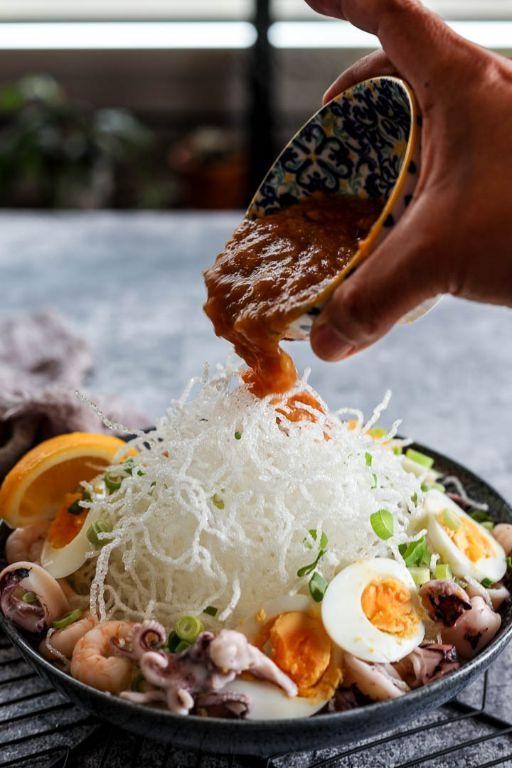
Offering a vibrant twist on Filipino comfort, this Spicy Pancit Palabok with Crispy Chicharron brings together silky rice noodles bathed in a rich, golden shrimp sauce, crowned with crunchy pork cracklings that provide the perfect textural contrast. Originating from coastal regions where fresh seafood abounds, this dish balances umami depth with a gentle heat that awakens the palate without overwhelming it. Each component harmonizes beautifully, creating a symphony of flavors that feels both celebratory and deeply satisfying.
Ingredients
– 8 oz rice noodles (I prefer the thin variety for better sauce absorption)
– 1/4 cup annatto seeds soaked in 1/2 cup hot water (this creates the signature golden hue)
– 1/2 lb small shrimp, peeled and deveined (save the shells for the sauce)
– 4 cloves garlic, minced (freshly crushed releases more aromatic oils)
– 1 medium onion, finely diced
– 2 tbsp fish sauce (this is my preferred brand for balanced saltiness)
– 1 cup chicharron, crushed into 1/2-inch pieces (the fresh-fried variety provides superior crunch)
– 2 hard-boiled eggs, sliced (room temperature eggs slice more cleanly)
– 2 tbsp cooking oil
– 1 tsp calamansi juice (freshly squeezed brightens the entire dish)
– 1 red chili, thinly sliced (adjust based on your heat preference)
– 2 cups shrimp stock (homemade from reserved shells adds incredible depth)
– 2 tbsp cornstarch dissolved in 1/4 cup cold water
Instructions
1. Soak rice noodles in warm water for 15 minutes until pliable but not fully soft.
2. Heat oil in a large skillet over medium heat until it shimmers, about 1 minute.
3. Sauté garlic for 45 seconds until fragrant and lightly golden around the edges.
4. Add onions and cook for 3 minutes until translucent and sweetened.
5. Stir in shrimp and cook for 2 minutes per side until they turn pink and curl slightly.
6. Pour in strained annatto water and shrimp stock, bringing to a gentle boil.
7. Whisk in cornstarch slurry and cook for exactly 2 minutes until sauce thickens to coat the back of a spoon.
8. Season with fish sauce and calamansi juice, stirring to incorporate completely.
9. Drain soaked noodles and add to sauce, tossing for 3 minutes until evenly coated and heated through.
10. Arrange noodles on serving platter and top with crushed chicharron, egg slices, and chili.
Velvety noodles cling to the luxuriously thick sauce while the chicharron maintains its satisfying crackle against each bite. The subtle heat from fresh chili builds gradually, complementing rather than dominating the complex umami notes. For an elegant presentation, serve in individual bowls garnished with extra calamansi wedges and fresh cilantro sprigs.
Pancit Habhab with Vinegar
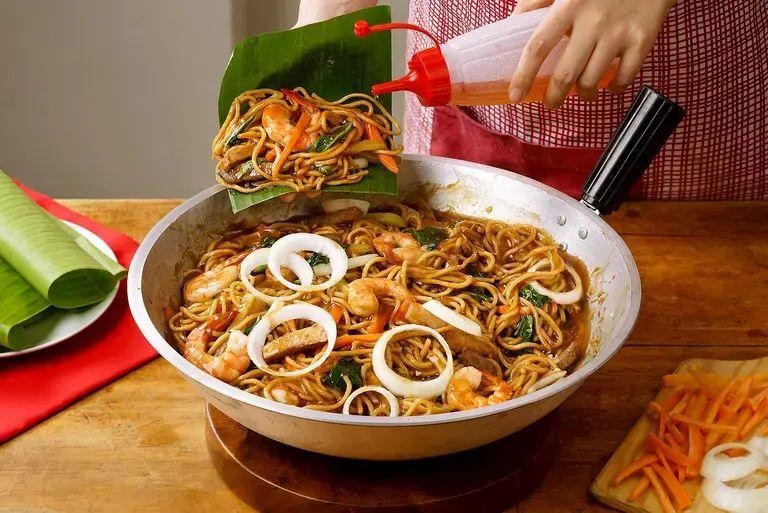
Unfolding before you is a vibrant Filipino street food classic reimagined for the home kitchen—Pancit Habhab with Vinegar. This stir-fried noodle dish, traditionally served on banana leaves and eaten without utensils, offers a delightful play of textures and a bright, tangy finish. Its quick-cooking nature makes it perfect for a weeknight dinner that feels anything but ordinary.
Ingredients
- 8 ounces dried rice sticks (bihon)—I find the thinner variety absorbs the sauce beautifully
- 2 tablespoons vegetable oil—a neutral oil lets the other flavors shine
- 3 cloves garlic, minced—freshly minced garlic provides the best aromatic base
- 1 small yellow onion, thinly sliced—slicing it thinly ensures it softens evenly
- 1 cup shredded cooked chicken—using leftover rotisserie chicken saves time
- 1 cup thinly sliced cabbage—I like the crunch it adds at the end
- 1 carrot, julienned—for a pop of color and subtle sweetness
- 3 tablespoons soy sauce—I prefer low-sodium to control the saltiness
- 1 cup chicken broth—homemade broth elevates the dish, but store-bought works too
- 1/4 cup cane vinegar—its mild acidity balances the savory notes
- 2 green onions, sliced—for a fresh, crisp garnish
Instructions
- Place the dried rice sticks in a large bowl and cover with warm water; soak for 15 minutes until pliable but not fully soft, then drain thoroughly.
- Heat the vegetable oil in a large wok or skillet over medium-high heat until it shimmers, about 1 minute.
- Add the minced garlic and sliced onion to the hot oil; sauté for 2–3 minutes until the onion turns translucent and the garlic is fragrant but not browned.
- Stir in the shredded chicken and cook for 1 minute to warm through and lightly crisp the edges.
- Add the sliced cabbage and julienned carrot; toss continuously for 2–3 minutes until the cabbage just begins to wilt.
- Pour in the soy sauce and chicken broth, then bring the mixture to a gentle boil.
- Add the drained rice sticks to the wok, using tongs to gently separate and coat them in the liquid.
- Reduce the heat to medium and simmer for 5–7 minutes, stirring occasionally, until the noodles have absorbed most of the liquid and are tender.
- Drizzle the cane vinegar evenly over the noodles and toss to combine; cook for 1 additional minute to allow the vinegar to meld with the other flavors.
- Remove from heat and garnish with sliced green onions.
Here, the noodles achieve a perfect balance—tender yet springy, with the vinegar cutting through the richness of the soy and chicken. Serve it family-style in a large bowl, or for an authentic touch, mound portions onto banana leaves and let everyone dig in with their hands.
Pancit Luglug with Hard-Boiled Eggs

Nestled within the vibrant tapestry of Filipino cuisine, Pancit Luglug emerges as a celebratory noodle dish, its thick rice strands bathed in a rich, savory shrimp sauce that clings beautifully to each component. Traditionally served during fiestas and family gatherings, this version gains delightful texture and protein from hard-boiled eggs, creating a harmonious balance in every bite. Preparing this dish invites both culinary tradition and personal creativity to your table, promising a truly satisfying meal.
Ingredients
– 8 ounces thick rice sticks (bihon), my preferred brand for its perfect chew
– 1 pound medium shrimp, peeled and deveined but saving the shells for maximum flavor
– 4 cups shrimp stock, homemade from those reserved shells if you have time
– 3 tablespoons annatto powder, which gives that beautiful golden-orange hue
– 1/4 cup fish sauce, the good quality kind makes all the difference
– 1 large onion, finely diced
– 4 cloves garlic, minced until fragrant
– 2 tablespoons cooking oil, I always use avocado oil for its high smoke point
– 4 hard-boiled eggs, peeled and sliced into rounds
– 1 cup green beans, trimmed and cut into 1-inch pieces
– 1 cup cabbage, thinly sliced for quick cooking
– 2 tablespoons cornstarch, mixed with 1/4 cup cold water for the perfect sauce consistency
Instructions
1. Place rice sticks in a large bowl and cover completely with warm water, soaking for 15 minutes until pliable but not mushy.
2. Heat oil in a large wok or Dutch oven over medium heat until shimmering, about 1 minute.
3. Sauté onions for 3-4 minutes until translucent, stirring frequently to prevent burning.
4. Add garlic and cook for 1 minute until fragrant but not browned.
5. Stir in annatto powder until dissolved and the oil turns bright orange.
6. Add shrimp and cook for 2-3 minutes per side until pink and opaque.
7. Pour in shrimp stock and fish sauce, bringing to a gentle boil.
8. Reduce heat to low and simmer for 10 minutes to develop flavors.
9. Drain soaked rice sticks thoroughly and add to the simmering sauce.
10. Cook noodles for 5 minutes, stirring gently to prevent sticking.
11. Add green beans and cabbage, cooking for 3 more minutes until vegetables are tender-crisp.
12. Slowly pour in cornstarch slurry while stirring constantly.
13. Continue cooking for 2 minutes until sauce thickens and coats the noodles evenly.
14. Remove from heat and let rest for 2 minutes to allow flavors to meld.
15. Transfer to serving platter and arrange hard-boiled egg slices decoratively on top.
What makes this dish truly special is the way the thick, glossy sauce clings to each noodle strand, while the hard-boiled eggs provide creamy contrast to the savory shrimp and crisp vegetables. For an elegant presentation, serve in individual bowls garnished with fresh calamansi wedges and crispy garlic chips, allowing guests to customize their perfect bite. The combination of textures—from the springy noodles to the firm eggs and crunchy beans—creates a symphony of sensations that celebrates both tradition and innovation.
Pancit Mami with Tender Beef Strips
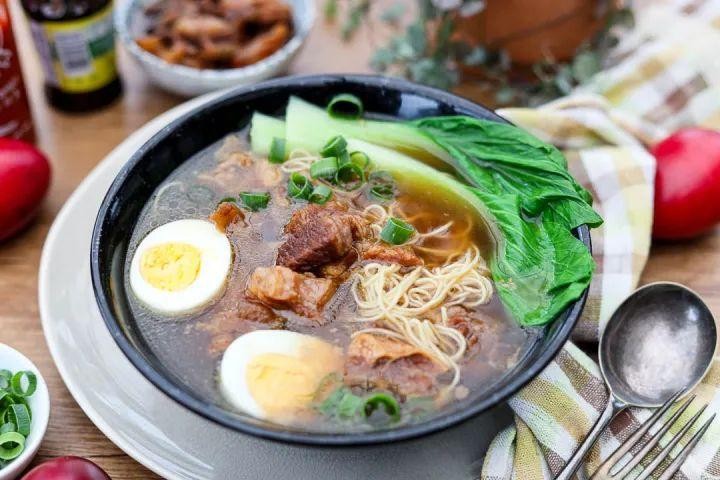
Luminous with golden noodles and rich aromatics, this Filipino-inspired Pancit Mami brings comforting warmth to any table. Tender beef strips simmer gently in a deeply flavored broth, creating a dish that feels both nourishing and celebratory. Each bowl promises the perfect balance of savory depth and delicate textures that will transport your senses.
Ingredients
– 1 lb beef sirloin, sliced into thin strips against the grain for maximum tenderness
– 8 oz fresh egg noodles, which provide that wonderful springy texture I adore
– 6 cups beef broth, preferably low-sodium so you control the seasoning
– 1 large yellow onion, thinly sliced to melt beautifully into the broth
– 4 cloves garlic, minced—I always use fresh for that pungent kick
– 2 tbsp vegetable oil, my neutral choice that lets other flavors shine
– 1 tbsp fish sauce, that essential umami booster
– 1 tsp freshly ground black pepper, coarsely ground for better flavor release
– 2 hard-boiled eggs, sliced for garnish—room temperature eggs peel more cleanly
– 4 green onions, chopped for that fresh, colorful finish
Instructions
1. Heat vegetable oil in a large Dutch oven over medium-high heat until shimmering, about 2 minutes.
2. Add beef strips in a single layer and sear until browned on all sides, approximately 4-5 minutes total—don’t overcrowd the pan to ensure proper browning.
3. Transfer beef to a clean plate, preserving those flavorful browned bits in the pot.
4. Reduce heat to medium and sauté onions until translucent and fragrant, about 3 minutes.
5. Add minced garlic and cook until golden and aromatic, approximately 1 minute—watch closely as garlic burns easily.
6. Pour in beef broth, scraping the bottom to incorporate all the flavorful fond.
7. Return beef strips to the pot along with any accumulated juices.
8. Stir in fish sauce and black pepper, then bring to a gentle boil.
9. Reduce heat to low, cover, and simmer for 25 minutes until beef becomes fork-tender.
10. Add fresh egg noodles and cook for exactly 4 minutes until al dente—timing is crucial here to prevent mushy noodles.
11. Ladle into deep bowls and top with hard-boiled egg slices and chopped green onions.
Completing this dish reveals silky noodles that soak up the rich, savory broth while maintaining their delightful chew. The beef strips become remarkably tender, offering a satisfying contrast to the springy noodles. For an elegant presentation, serve in wide, shallow bowls to showcase the beautiful layers of ingredients, perhaps with a side of chili oil for those who enjoy extra heat.
Pancit Chami with Sweet and Savory Sauce
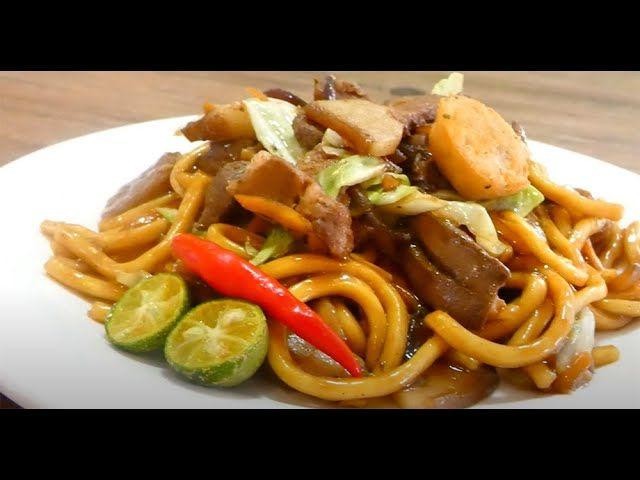
Beneath the golden glow of late afternoon light, there exists a dish that masterfully bridges culinary traditions—Pancit Chami with Sweet and Savory Sauce, where tender noodles embrace a complex, glossy coating that dances between honeyed notes and umami depth, creating a symphony in every forkful.
Ingredients
- 8 ounces fresh egg noodles (I find the springy texture unbeatable when fresh)
- 2 tablespoons vegetable oil (a neutral oil lets the other flavors shine)
- 3 cloves garlic, minced (freshly minced releases the most aromatic punch)
- 1 small onion, finely chopped (yellow onions add a subtle sweetness)
- 1/2 pound pork shoulder, thinly sliced (marbled cuts stay incredibly tender)
- 1/4 cup soy sauce (I prefer low-sodium to control saltiness)
- 2 tablespoons oyster sauce (this is my secret umami booster)
- 2 tablespoons honey (local wildflower honey adds floral notes)
- 1 tablespoon rice vinegar (a splash brightens the entire dish)
- 1 cup shredded cabbage (it retains a lovely crunch when lightly cooked)
- 1 carrot, julienned (I always keep the pieces thin for quick cooking)
- 2 green onions, sliced (reserve some for garnish—it makes all the difference)
- 1/2 teaspoon black pepper (freshly cracked elevates the warmth)
Instructions
- Bring a large pot of salted water to a rolling boil over high heat.
- Add fresh egg noodles and cook for exactly 3 minutes until al dente, stirring once to prevent sticking.
- Drain noodles immediately and rinse under cold water to stop cooking, then toss with 1 teaspoon vegetable oil to prevent clumping.
- Heat remaining vegetable oil in a large wok or skillet over medium-high heat until it shimmers, about 1 minute.
- Add minced garlic and chopped onion, sautéing for 2 minutes until fragrant and translucent.
- Add thinly sliced pork shoulder and cook for 4-5 minutes, stirring frequently, until no pink remains.
- Pour in soy sauce, oyster sauce, honey, and rice vinegar, stirring to combine completely.
- Simmer sauce uncovered for 3 minutes until slightly thickened and glossy.
- Add shredded cabbage and julienned carrot, tossing for 2 minutes until vegetables are just tender but still crisp.
- Fold in cooked noodles and black pepper, stirring gently for 2 minutes until everything is evenly coated and heated through.
- Remove from heat and garnish with reserved sliced green onions.
When served immediately, the noodles boast a springy chew against the silky sauce, while the pork remains remarkably succulent. For an elegant presentation, top with a fried egg whose runny yolk mingles beautifully with the sweet-savory glaze, or accompany with pickled vegetables to cut through the richness.
Pancit Puso ng Saging with Native Banana Blossoms
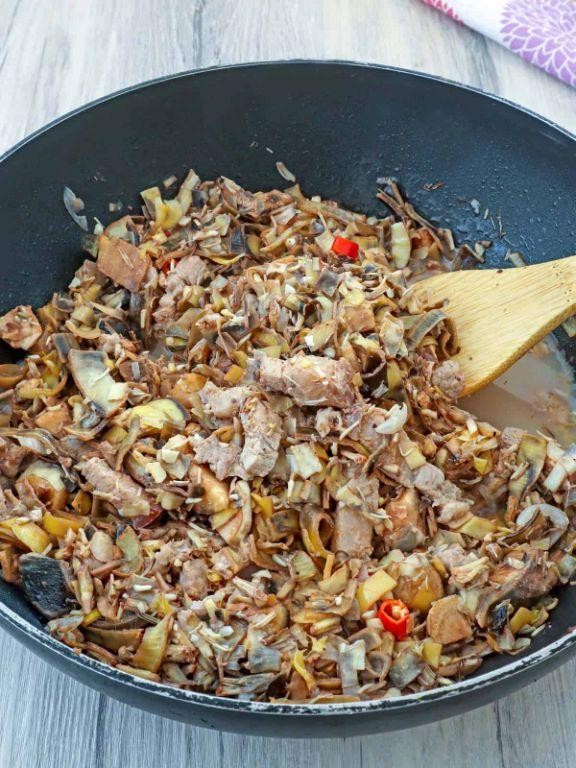
Meticulously crafted and deeply rooted in Filipino culinary tradition, this Pancit Puso ng Saging offers a sophisticated twist on classic noodle dishes. The native banana blossoms lend an earthy elegance that pairs beautifully with the delicate rice noodles, creating layers of texture and flavor. This dish transforms humble ingredients into something truly extraordinary for the modern table.
Ingredients
– 8 ounces dried rice noodles (I always soak these in warm water first for perfect texture)
– 2 cups fresh banana blossoms, thinly sliced (look for firm, purple-tinged blossoms at Asian markets)
– 1 large yellow onion, finely diced (sweet onions work beautifully here)
– 4 cloves garlic, minced (freshly minced makes all the difference)
– 1 pound chicken thighs, boneless and skinless (thighs stay wonderfully moist)
– 3 tablespoons vegetable oil (a neutral oil lets the other flavors shine)
– 1/4 cup soy sauce (I prefer low-sodium for better control)
– 2 tablespoons fish sauce (this adds that essential umami depth)
– 1 cup chicken broth (homemade if you have it)
– 1 teaspoon black pepper, freshly ground
– 2 hard-boiled eggs, sliced (room temperature eggs slice cleanly)
– 1/4 cup green onions, chopped (for that fresh finish)
Instructions
1. Place 8 ounces dried rice noodles in a large bowl and cover with warm water, soaking for 15 minutes until pliable but not fully soft.
2. While noodles soak, thinly slice 2 cups fresh banana blossoms and immediately place in cold water to prevent discoloration.
3. Heat 3 tablespoons vegetable oil in a large wok or skillet over medium-high heat until shimmering, about 350°F.
4. Add 1 large finely diced yellow onion and cook for 3-4 minutes until translucent and fragrant.
5. Stir in 4 cloves minced garlic and cook for 1 minute until golden but not browned.
6. Add 1 pound chicken thighs cut into bite-sized pieces and cook for 6-8 minutes until no longer pink.
7. Drain the banana blossoms thoroughly and add to the wok, stirring to combine with the chicken mixture.
8. Pour in 1/4 cup soy sauce and 2 tablespoons fish sauce, stirring to coat all ingredients evenly.
9. Add 1 cup chicken broth and 1 teaspoon freshly ground black pepper, bringing the mixture to a gentle simmer.
10. Drain the soaked rice noodles and add to the wok, using tongs to gently separate strands as they cook.
11. Cook for 5-7 minutes, tossing frequently, until noodles have absorbed most of the liquid and are tender.
12. Remove from heat and garnish with 2 sliced hard-boiled eggs and 1/4 cup chopped green onions.
Remarkably textured with the slight crunch of banana blossoms against silky noodles, this dish delivers complex savory notes balanced by the freshness of green onions. The sliced eggs add both visual appeal and creamy contrast, making it perfect for elegant dinner parties or sophisticated weeknight meals. Serve it family-style in a large ceramic bowl to showcase its beautiful layers and colors.
Pancit Lomi with Thick Egg Noodles
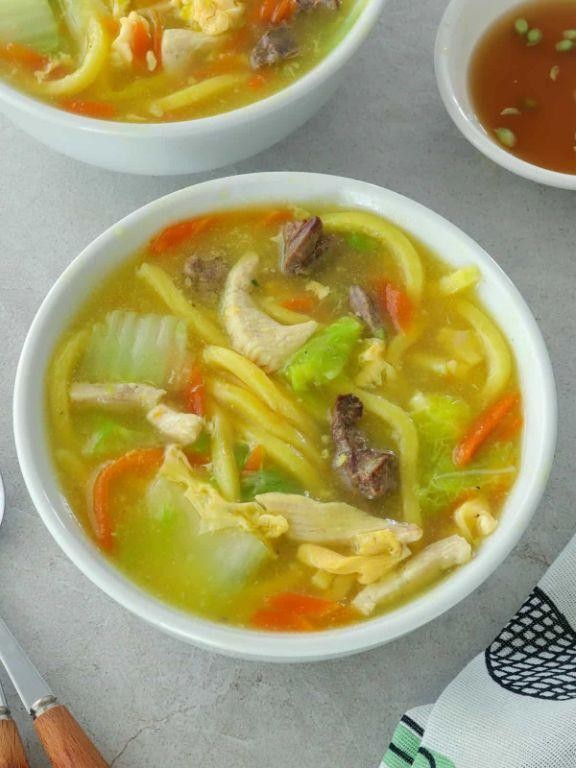
Venturing into the heartwarming world of Filipino comfort cuisine reveals Pancit Lomi, a soul-satisfying noodle soup where thick, chewy egg noodles swim in a rich, savory broth, creating a symphony of textures and flavors that comforts from the very first spoonful.
Ingredients
- 8 ounces thick fresh egg noodles—I find the refrigerated kind have the perfect springy texture
- 1 pound boneless chicken thighs, sliced thin—thighs stay juicier than breast meat
- 1/2 pound medium shrimp, peeled and deveined—save those shells for extra flavor
- 4 cups chicken broth—homemade if you have it, but good quality store-bought works beautifully
- 1 cup sliced cabbage—I like the crunch it adds against the soft noodles
- 1/2 cup sliced carrots—cut on a diagonal for elegant presentation
- 1/4 cup soy sauce—use light soy for better broth color
- 2 tablespoons fish sauce—this is the secret umami booster
- 1 tablespoon cornstarch mixed with 2 tablespoons water—my trick for that signature glossy broth
- 2 cloves garlic, minced—freshly minced makes all the difference
- 1 tablespoon vegetable oil—a neutral oil lets the other flavors shine
- 2 hard-boiled eggs, quartered—for that classic finishing touch
- 1/4 cup chopped green onions—the fresh pop of color at the end
Instructions
- Heat vegetable oil in a large pot over medium heat until shimmering.
- Sauté minced garlic for exactly 45 seconds until fragrant but not browned—this prevents bitterness.
- Add sliced chicken thighs and cook for 4 minutes, stirring occasionally, until no longer pink.
- Pour in chicken broth and bring to a gentle boil over high heat.
- Reduce heat to medium-low and simmer uncovered for 8 minutes to develop flavors.
- Add thick egg noodles and cook for 3 minutes, stirring gently to separate strands.
- Stir in sliced cabbage and carrots, cooking for another 2 minutes until vegetables are tender-crisp.
- Add shrimp and cook for exactly 90 seconds until they turn pink and curl slightly—overcooking makes them rubbery.
- Pour in soy sauce and fish sauce, stirring to incorporate evenly.
- Give the cornstarch slurry a quick stir and drizzle into the soup while stirring constantly.
- Cook for 1 more minute until the broth thickens to a glossy, coating consistency.
- Remove from heat and ladle into deep bowls immediately.
Sublime in its simplicity, this Pancit Lomi delivers a luxurious mouthfeel where the thick noodles cling to the savory broth, while the shrimp and chicken provide contrasting textures. Serve it steaming hot with quartered hard-boiled eggs nestled on top and a generous sprinkle of green onions for that final fresh note—perfect for cozy evenings when only a bowl of profound comfort will do.
Coconut-Infused Pancit Buko
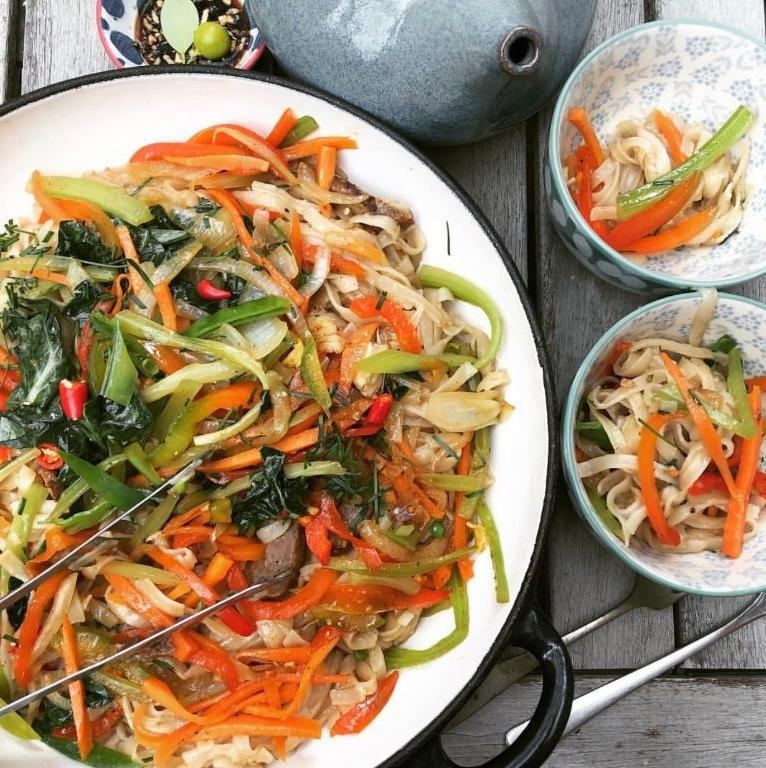
Meticulously crafted to elevate the traditional Filipino noodle dish, this Coconut-Infused Pancit Buko transforms humble ingredients into an extraordinary culinary experience where delicate rice noodles dance with the tropical sweetness of young coconut. The subtle infusion of coconut water and milk creates a harmonious balance that whispers of island breezes while maintaining the savory depth expected of classic pancit. Each component is carefully chosen to build layers of texture and flavor that will transport your senses to a sun-drenched Philippine shoreline.
Ingredients
– 8 ounces rice sticks (I find the thinner variety absorbs the coconut flavors more beautifully)
– 2 cups fresh young coconut water (seek out the refrigerated kind for brightest flavor)
– 1 cup coconut milk (full-fat gives the richest texture)
– 2 tablespoons vegetable oil (I prefer avocado oil for its high smoke point)
– 3 cloves garlic, minced (freshly crushed releases the most aromatic oils)
– 1 small yellow onion, thinly sliced (sweet varieties like Vidalia work wonderfully)
– 1 cup shredded cooked chicken (rotisserie chicken saves time without sacrificing quality)
– 1 cup fresh young coconut meat, julienned (the tender texture is worth seeking out)
– 2 tablespoons soy sauce (I always use reduced-sodium to control saltiness)
– 1 tablespoon calamansi juice (freshly squeezed makes all the difference)
– ¼ cup green onions, sliced (reserve the green tops for garnish)
– 1 carrot, julienned (I cut mine into matchsticks for even cooking)
Instructions
1. Soak rice sticks in warm water for 15 minutes until pliable but not fully soft, then drain completely.
2. Heat vegetable oil in a large wok or skillet over medium-high heat until it shimmers, about 2 minutes.
3. Sauté garlic for 30 seconds until fragrant but not browned, stirring constantly with a wooden spoon.
4. Add sliced onion and cook for 3 minutes until translucent and slightly softened.
5. Incorporate shredded chicken and cook for 2 minutes until heated through and lightly seared.
6. Pour in coconut water and bring to a gentle boil, which should take approximately 4 minutes.
7. Add drained rice sticks, spreading them evenly across the liquid, and cook for 5 minutes.
8. Pour coconut milk over the noodles, stirring gently to combine without breaking the noodles.
9. Mix in julienned carrot and coconut meat, cooking for 3 minutes until carrots are tender-crisp.
10. Drizzle soy sauce and calamansi juice evenly across the surface of the dish.
11. Cook for 2 more minutes, tossing continuously to ensure even distribution of flavors.
12. Fold in green onions and cook for 1 final minute until slightly wilted.
The finished dish presents with noodles that maintain a satisfying chew while absorbing the coconut’s delicate sweetness, creating a symphony of textures from the crisp vegetables to the tender coconut strips. Serve immediately in shallow bowls, perhaps garnished with additional calamansi wedges for those who enjoy an extra citrus kick, making it perfect for both casual family dinners and impressive entertaining.
Pancit Estacion with Batangas Sauce
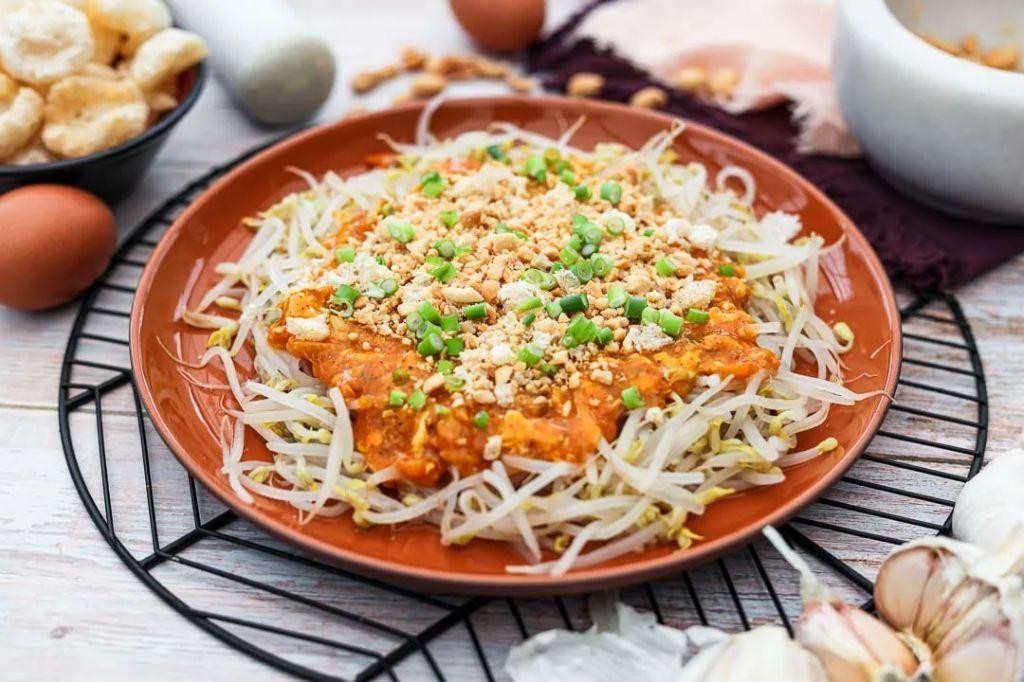
Savoring the vibrant flavors of Filipino street food at home becomes an extraordinary experience with this elevated version of Pancit Estacion, where thin rice noodles meet the bold, citrus-kissed Batangas sauce that defines the region’s culinary spirit. This dish transforms humble ingredients into a symphony of textures and tastes, perfect for both weeknight dinners and special gatherings. Each bite carries the warmth of Filipino hospitality, bridging tradition with contemporary elegance.
Ingredients
- 8 ounces thin rice noodles, which I always soak briefly in warm water to prevent breakage
- 2 tablespoons vegetable oil, my preferred neutral base for achieving that perfect sear
- 3 cloves garlic, minced—I insist on fresh cloves for their aromatic punch
- 1 medium yellow onion, thinly sliced to melt into the sauce beautifully
- 1 pound chicken thighs, boneless and skinless, diced into ½-inch pieces for even cooking
- 1 cup chicken broth, using homemade when possible for deeper flavor
- ¼ cup soy sauce, which I opt for reduced-sodium to control saltiness
- 3 tablespoons calamansi juice, freshly squeezed for that essential citrus brightness
- 1 tablespoon fish sauce, a non-negotiable umami booster in my kitchen
- 1 teaspoon black pepper, freshly ground to release its aromatic oils
- 2 hard-boiled eggs, sliced—I let them cool completely for cleaner cuts
- ¼ cup green onions, thinly sliced as a vibrant finishing touch
- 1 lemon, wedged for serving to let guests adjust acidity to their liking
Instructions
- Place rice noodles in a large bowl and cover with warm water for 8 minutes until pliable but not fully soft.
- Heat vegetable oil in a large wok or skillet over medium-high heat until it shimmers, about 1 minute.
- Add minced garlic and sliced onion, sautéing for 2 minutes until fragrant and translucent.
- Add diced chicken thighs and cook for 6 minutes, stirring occasionally, until golden brown on all sides.
- Pour in chicken broth, soy sauce, calamansi juice, and fish sauce, then bring to a gentle boil.
- Reduce heat to medium-low and simmer uncovered for 10 minutes until chicken is cooked through.
- Drain soaked noodles thoroughly and add to the skillet, tossing to coat evenly with sauce.
- Cook for 4 minutes, stirring constantly, until noodles absorb most of the liquid and become tender.
- Sprinkle freshly ground black pepper over the noodles and toss once more to distribute evenly.
- Transfer to serving plates and garnish with sliced hard-boiled eggs and green onions.
- Serve immediately with lemon wedges on the side for squeezing over individual portions.
Crisp-tender noodles cling to the robust Batangas sauce, creating a delightful contrast against the succulent chicken pieces. The calamansi’s bright acidity cuts through the richness, while fish sauce adds an irresistible savory depth that lingers on the palate. For an unforgettable presentation, serve family-style in a large ceramic bowl, allowing guests to customize their plates with extra lemon wedges and perhaps a sprinkle of chili flakes for those who crave heat.
Pancit Tuguegarao Loglog with Local Longganisa

Radiating with the vibrant soul of Northern Luzon, this Pancit Tuguegarao Loglog brings together thin rice noodles and savory local longganisa in a celebration of Filipino comfort. Richly seasoned with annatto oil and fish sauce, each component melds into a harmonious dish that feels both rustic and refined. It’s a bowl that whispers of bustling market mornings and family gatherings around the table.
Ingredients
- 8 ounces thin rice noodles (I like to soak these briefly for easier handling)
- 1 tablespoon annatto seeds (these lend such a beautiful golden hue)
- ½ cup neutral oil, like canola (my go-to for high-heat sautéing)
- 6 ounces local longganisa, casings removed and crumbled (room temperature makes crumbling simpler)
- 4 cloves garlic, minced (freshly minced releases the best aroma)
- 1 medium onion, thinly sliced
- 2 tablespoons fish sauce (this is my preferred brand for its balanced saltiness)
- ½ teaspoon ground black pepper
- 2 cups shredded cabbage
- 1 cup bean sprouts
- 2 hard-boiled eggs, sliced (I find room temperature eggs slice more cleanly)
- 2 calamansi or small limes, halved (for that essential bright finish)
Instructions
- Place rice noodles in a large bowl and cover with warm water; soak for 10 minutes until pliable but not fully soft.
- Heat annatto seeds and oil in a small saucepan over medium heat for 3 minutes until oil turns deep orange; strain out seeds and discard.
- Heat 2 tablespoons of the annatto oil in a large wok or skillet over medium-high heat until shimmering.
- Add crumbled longganisa and cook for 5–6 minutes, breaking it up with a spoon, until browned and crispy at the edges.
- Stir in minced garlic and sliced onion; sauté for 2 minutes until fragrant and onion is translucent.
- Drain the soaked noodles thoroughly and add to the wok along with fish sauce and black pepper.
- Toss continuously for 4–5 minutes until noodles are tender and evenly coated with oil and seasonings.
- Add shredded cabbage and bean sprouts; cook for 2 more minutes just until vegetables are wilted but still crisp.
- Remove from heat and drizzle with remaining annatto oil for extra color and richness.
- Garnish with sliced hard-boiled eggs and serve immediately with calamansi halves on the side.
Tender noodles cling to the savory, slightly sweet longganisa, while the cabbage and sprouts offer a refreshing crunch. The annatto oil not only paints the dish a warm gold but also imparts a subtle earthy note that balances the saltiness of the fish sauce. For a festive twist, serve it family-style in a large wooden bowl, letting everyone squeeze fresh calamansi over their portion to brighten each bite.
Pancit Cabagan with Lechon Carajay Topping
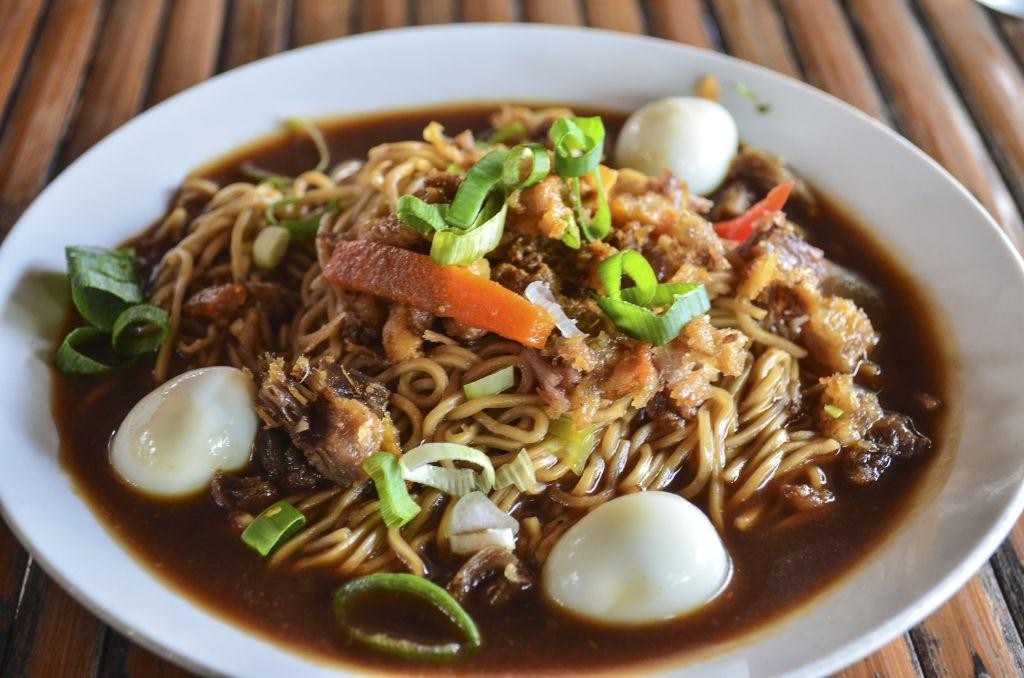
Zesty and vibrant, this Filipino noodle dish transforms humble ingredients into an unforgettable culinary experience that balances savory, tangy, and crisp textures in perfect harmony. Pancit Cabagan celebrates the art of noodle-making with its rich pork-based sauce and delicate wheat noodles, while the Lechon Carajay topping adds a spectacular crunch that elevates every bite. Each component works in symphony to create a dish that feels both comforting and celebratory.
Ingredients
- 8 ounces thin wheat noodles (I always use Canton-style for their perfect chew)
- 1 pound pork belly, sliced into ½-inch pieces (freeze for 15 minutes first for easier slicing)
- 3 tablespoons vegetable oil (a neutral oil works best here for high-heat frying)
- 4 cloves garlic, minced (freshly minced releases the most aromatic oils)
- 1 medium onion, thinly sliced (yellow onions provide the ideal sweetness)
- ¼ cup soy sauce (I prefer reduced-sodium to control saltiness)
- 2 tablespoons calamansi juice (freshly squeezed makes all the difference)
- 1 teaspoon freshly ground black pepper
- 2 cups pork broth (homemade adds incredible depth)
- 2 cups shredded cabbage (the crunch is essential)
- ½ cup sliced carrots (cut on a bias for visual appeal)
- 2 hard-boiled eggs, quartered (room temperature eggs slice cleanly)
- ¼ cup chopped scallions (reserve the green parts for garnish)
Instructions
- Bring a large pot of water to a rolling boil over high heat, then add the wheat noodles and cook for exactly 4 minutes until al dente.
- Drain the noodles immediately in a colander and rinse with cold water to stop the cooking process, then toss with 1 tablespoon vegetable oil to prevent sticking.
- Heat the remaining 2 tablespoons vegetable oil in a large wok or skillet over medium-high heat until shimmering, about 2 minutes.
- Add the pork belly slices in a single layer and cook for 8-10 minutes, flipping every 2 minutes, until golden brown and crispy.
- Remove the crispy pork belly with a slotted spoon and set aside on a paper towel-lined plate, reserving 2 tablespoons of rendered fat in the wok.
- Add the minced garlic to the hot fat and sauté for 45 seconds until fragrant but not browned, stirring constantly.
- Add the sliced onion and cook for 3 minutes until translucent and slightly softened.
- Pour in the soy sauce and calamansi juice, then add the black pepper, stirring to combine and scraping any browned bits from the bottom.
- Add the pork broth and bring to a vigorous boil, then reduce heat to medium and simmer for 5 minutes to develop the flavors.
- Add the cooked noodles to the sauce, tossing gently with tongs to coat evenly, and cook for 2 minutes until the noodles absorb some liquid.
- Stir in the shredded cabbage and sliced carrots, cooking for exactly 3 minutes until vegetables are tender-crisp.
- Transfer the noodle mixture to a serving platter, top with the crispy pork belly, and garnish with hard-boiled egg quarters and chopped scallions.
Kaleidoscopic in both appearance and taste, this dish delivers contrasting textures that make each forkful exciting—the silky noodles against the crackling pork creates a sensory experience that’s truly memorable. Serve it family-style with extra calamansi wedges for squeezing over the top, allowing guests to customize the bright citrus notes to their preference. The beautiful layering of flavors—savory, tangy, and rich—makes this perfect for special occasions where you want to impress while still feeling completely approachable.
Modern Pancit Negra with Squid Ink

Savoring the deep, oceanic essence of this Filipino classic, Modern Pancit Negra with Squid Ink transforms traditional rice noodles into an elegant, jet-black delicacy that marries heritage with contemporary flair. The squid ink imparts a subtle briny complexity, while the vibrant vegetables and tender proteins create a symphony of textures and flavors that feel both comforting and sophisticated. This dish offers a stunning visual contrast on the plate, making it perfect for both weeknight dinners and special occasions.
Ingredients
– 8 oz dried rice noodles (I always soak these in warm water first for easier handling)
– 2 tbsp squid ink (look for the small jars in specialty markets—they’re worth the hunt)
– 1 lb fresh squid, cleaned and sliced into rings (fresh makes all the difference here)
– 2 tbsp extra virgin olive oil (my go-to for its fruity notes)
– 3 cloves garlic, minced (freshly minced releases the best aroma)
– 1 medium yellow onion, thinly sliced
– 1 red bell pepper, julienned
– 2 cups shredded Napa cabbage
– 3 tbsp soy sauce
– 1 tbsp fish sauce
– 1 tsp freshly ground black pepper
– 2 cups chicken broth (homemade if you have it)
– 2 tbsp fresh calamansi juice (or substitute with lime juice)
– ¼ cup chopped green onions
– 2 hard-boiled eggs, sliced (I prefer room temperature eggs for easier slicing)
Instructions
1. Place rice noodles in a large bowl and cover with warm water for 15 minutes until pliable but still firm.
2. Heat olive oil in a large wok or skillet over medium-high heat until shimmering.
3. Add garlic and cook for 45 seconds until fragrant and lightly golden.
4. Add onion slices and cook for 2 minutes until translucent.
5. Add squid rings and cook for 3 minutes until they turn opaque and curl slightly.
6. Stir in red bell pepper and cabbage, cooking for 2 minutes until vegetables begin to soften.
7. Drain soaked noodles thoroughly and add to the wok.
8. Pour in chicken broth and bring to a gentle simmer.
9. Add squid ink, stirring continuously until noodles are evenly coated in black color.
10. Season with soy sauce, fish sauce, and black pepper, stirring to combine.
11. Reduce heat to medium and cook for 8 minutes, stirring occasionally until liquid is mostly absorbed.
12. Drizzle calamansi juice over the noodles and toss to incorporate.
13. Remove from heat and let rest for 2 minutes to allow flavors to meld.
14. Garnish with green onions and arrange hard-boiled egg slices on top.
Velvety black noodles cling to tender squid and crisp vegetables in this dramatic presentation. The squid ink creates an earthy undertone that perfectly balances the bright acidity of calamansi, while the hard-boiled eggs add creamy contrast to each bite. Serve this stunning dish family-style with extra calamansi wedges for squeezing at the table, allowing guests to customize the tanginess to their preference.
Pancit Wonton Soup with Pork Dumplings

Kindling warmth in both bowl and soul, this Pancit Wonton Soup with Pork Dumplings marries the delicate artistry of Filipino-Chinese cuisine with comforting, brothy depths that feel like a culinary embrace on even the most brisk of days. Each tender dumpling and slender noodle strand promises a symphony of textures and flavors, elevating the humble soup into an elegant centerpiece worthy of any gathering.
Ingredients
– 1 lb ground pork (I prefer 80/20 for juicier dumplings)
– 24 wonton wrappers, kept under a damp towel to prevent drying
– 8 cups chicken broth, preferably homemade for richer flavor
– 4 oz pancit canton noodles, the thin, wheat-based variety
– 2 tbsp soy sauce, my secret is using dark soy for depth
– 1 tbsp sesame oil, toasted for nutty aroma
– 3 cloves garlic, minced (freshly crushed releases more oils)
– 1 inch ginger, julienned
– 2 green onions, sliced—reserve the green tops for garnish
– 1 cup Napa cabbage, finely shredded
– 1 large egg, lightly beaten for sealing wontons
Instructions
1. Combine ground pork, half the minced garlic, 1 tablespoon soy sauce, and half the green onions in a bowl.
2. Place 1 teaspoon of pork mixture in the center of each wonton wrapper.
3. Brush edges of wrapper with beaten egg using a pastry brush.
4. Fold wrapper into a triangle, pressing edges firmly to seal.
5. Bring 8 cups chicken broth to a gentle simmer over medium heat in a large pot.
6. Add remaining garlic and julienned ginger to the broth.
7. Simmer broth for 10 minutes to infuse flavors.
8. Add pancit canton noodles to the broth.
9. Cook noodles for 4 minutes until al dente.
10. Gently drop pork dumplings into the simmering broth.
11. Cook dumplings for 5 minutes until they float to the surface.
12. Add shredded Napa cabbage during the last 2 minutes of cooking.
13. Stir in remaining soy sauce and sesame oil.
14. Ladle soup into bowls, ensuring even distribution of noodles and dumplings.
15. Garnish with reserved green onion tops.
Just as the final green onion garnish settles, the soup reveals its magic: silky noodles intertwine with plump dumplings that burst with savory pork, while the ginger-kissed broth carries whispers of sesame and soy. For an extra flourish, serve with chili crisp on the side—its fiery crunch contrasts beautifully with the soup’s delicate warmth, making each spoonful a study in balanced elegance.
Conclusion
Your culinary adventure awaits with these 21 authentic pancit recipes! From classic favorites to creative twists, there’s a perfect noodle dish for every home cook. We’d love to hear which recipes become your family favorites—leave a comment below and share your pancit creations on Pinterest so others can discover these delicious Filipino classics too!



